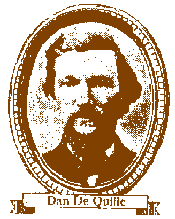Discovery of the Silver The Great Comstock Lode excerpted from The Big Bonanza by Dan DeQuille of the Territorial Enterprise |  |
Discovery of the Silver The Great Comstock Lode excerpted from The Big Bonanza by Dan DeQuille of the Territorial Enterprise |  |

In the spring of 1859, a considerable number of miners returned to six mile canyon to work. They made their headquarters at Gold Hill where two or three log houses including a large log boarding house had been erected.
Peter O'Riley and Pat McLaughlin set to work up at the head of ravine, where the ground began to rise toward the mountain. They used rockers and found small pay. They were becoming discouraged.
The manner in which the grand discovery was made was not very romantic. What our miners found was a great bed of black sulphuret of silver, a decomposed ore of silver filled with spangles of native gold. This gold, however, was alloyed with silver to such an extent that it was more the color of silver than of gold.
When the discoverers struck into the odd looking black dirt, they only thought that it was a sudden and rather singular change from the yellowish gravel and clay in which they had been digging. They at once concluded to try some of the curious looking stuff in their rockers.
The result astounded them. Before, they had only been taking out a dollar or two a day, but now they found the bottoms of their rockers covered with gold as soon as a few buckets of the new dirt had been washed. They found they were literally taking out gold by the pound. In a few weeks after the discovery had been made, and the work had been advanced further into the croppings of the lode they were taking out the gold at the rate of one thousand dollars per day. This they were doing with the rockers. Taking the harder lumps left on the screens of the rockers, one man was able to pound out gold at the rate of 100 dollars per day in a common hand mortar.
The Discovery of Silver For some weeks they dug down the rich decomposed silver ore, washed the gold out of it and let it go to waste, throwing it anywhere to get it out of the way of the rockers. Being very heavy it settled to the bottom of the rockers, covered up the quicksilver they contained and prevented the thorough amalgamation of the gold. The miners all thought well of the diggings but for this stuff. It was the great drawback.
About the first of July 1859, August Harrison, a ranch man living on the Truckey Meadows visited the new diggings about which so much was then said in the several settlements. He took a piece of the ore and going to California shortly afterwards carried it to Grass Valley, Nevada county. He gave the specimen as a curiousity, to Judge James Walsh, who took it to the office of Melville Atwood, an assayer in the town. The ore was assayed and yielded at the rate of several thousand dollars per ton in gold and silver.
All were astonished and not a little excited when it was ascertained that the black looking rock which the miners considered worthless and were throwing away was almost a solid mass of silver.
Three Months After Discovery The following extract from the Territorial Enterprise, then published as a weekly newspaper at Genoa (it is now published as a daily & weekly at Virginia City and is the leading paper of the city and state), will give some idea as to what was being done three months after the discovery. The item was published on Saturday, October 1 under the title of "The Mines."
The mines at Virginia town and Gold Hill are exceeding the most sanguine expectations of their owners. At Virginia town, particularly, the claims on the main leads promised to excel in richness the far-famed Allison lead in California in its palmiest days.
Claims are changing hands at almost fabulous prices. No fictitious sales, either, but bona-fide business operation. The main lead, on which is the celebrated Comstock and other claims, appears to be composed of ores producing both silver and gold, and the more it is prospected the richer it is proving.
Donald Davidson and Company, of San Francisco, have purchased 200 tons of rock containing gold and silver in conjunction, at $2,000 per ton and are shipping it to England by way of San Francisco, for assay and [smelting is meant]. Other parties are investing heavily. All that are now interested are but making preliminary arrangements for next spring, when we may expect to find an amount of either dust or ore sent from that section which will astonish some of the now incredulous ones in California.

Bridget E. Smith, editor & publisher
Email | Home Page | Dan DeQuille's Title Page
Historical Gazette
Published in Portland, Oregon
© 1991-